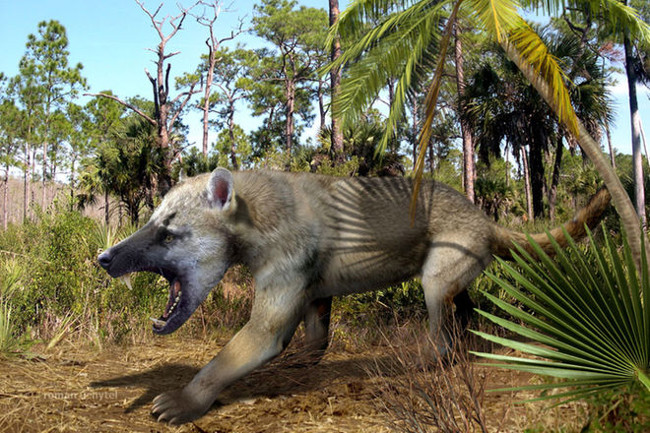Things to know about dog bears
The bear dog , also called Amphicyon, bears the characteristics of bears (large body, big feet with bare feet to stand upright with two legs ) and dogs ( relatively long legs and long muzzle ). However, they are not bears (Ursidae), nor are dogs (Canidae).
Based on science, they are particularly not the bear family nor the dog family, but they are in the dog group (Caniformia) or the "dog-like " subdivision . Modern animals in the dog form include wolves, foxes, dogs, bears, sea lions and ferrets. This makes the dog bear something like a cousin with the same name as them. In addition, this dog bear is easily confused with modern breeds, such as species Karelian bear dog.
 Not even bears, but dogs, this extinct animal has evolved into a giant predator.
Not even bears, but dogs, this extinct animal has evolved into a giant predator.
Photo source: Public domain
There are two main types of dog bears: One is the Borocyon robustum, which has long legs suitable for jumping activities and is similar to the modern wolf, the Amphicyon longiramus species , has a strong body and looks like modern bear. , according to the Florida Museum of Natural History.
Size
Like today's dogs and bears, the dog bears are large. They can weigh only a few pounds or can weigh up to (450kg). It is believed that the early evolution of the sun bear was very small, just the size of the Chihuahua dog (one of the smallest breeding dogs in the world). As it continued to grow, its size seemed to grow bigger, according to the Field Museum in Chicago.
When evolving into large animals there are several benefits and disadvantages. While body size is getting larger and larger, it will allow them to hunt larger prey and higher food chain, they also need more food and reproduce more slowly.
" Their enormous evolutionary size shows that they can prey on many mammals and other animals. Fortunately, they are extinct before humans are present in the world ," Wilkins said.
Living environment
Dog bears first appeared in Eurasian continent during the Eocene and Oligocene epochs (55.8 million to 23 million years ago), a time sufficient for warm weather and thick vegetation. Worldwide temperatures are about 30 degrees C (86 degrees F) in the Eocene world, according to the University of California Paleontology Museum.
Despite the cold temperatures in the Oligocene world, it is still quite warm and the vegetation flourishes in most locations around the world, including North America and Africa. The dog bear is extinct 5 million to 10 million years ago.
Diet
Dog bear teeth are formed to have an omnivorous diet , like the great bear and modern dog. Smaller bear's lures, which may be rodents, while larger sun bears, can eat larger animals such as wild pigs. In addition, dog bears can enjoy eating leaves and berries.
You should read it
- Why aren't the largest animals the fastest?
- 10 strange and unbelievable facts about animals you may not know
- Which animal brings the most deaths to humans?
- White polar bears die because of love loss that many people suffer
- 12 species of animals have the strangest vision in the natural world
- The world's 10 most endangered animals
- Pay homage to the three-set mausoleum, the wall of the tiger in the animal world
- The bank has to suspend operations because of the cat's actions
May be interested
- Things you should not leave in your car
 cars are a means of transport with a large storage capacity. however, you should not leave the following items in the car.
cars are a means of transport with a large storage capacity. however, you should not leave the following items in the car. - 5 things should be a little more and 5 things should be invested more
 do you know the 5 things that should be large expenses and 5 things that should be invested more? let's find out in this article!
do you know the 5 things that should be large expenses and 5 things that should be invested more? let's find out in this article! - Let go of these 10 things you will get more than you lose
 there are things if you accept to give up, you will be more lost, like the 10 things below.
there are things if you accept to give up, you will be more lost, like the 10 things below. - 16 small but wonderful things are only available in Japan
 let's explore 16 small but wonderful things only in japan that every country wants to get!
let's explore 16 small but wonderful things only in japan that every country wants to get! - To succeed, do 8 things before 8 am every day!
 life is always busy. it makes us feel like we never fulfill our own dreams. if you want to be successful, do 8 things before 8 am every day!
life is always busy. it makes us feel like we never fulfill our own dreams. if you want to be successful, do 8 things before 8 am every day! - 15 things computer users should know
 whether you are a seasoned technician or just a beginner, the following 15 things are essential for you and things you should know.
whether you are a seasoned technician or just a beginner, the following 15 things are essential for you and things you should know. - The mystery of the West: The special meaning of the J - Q - K cards
 in the deck of cards, the 'j, q, k' cards consist of 12 cards representing 12 months of the year. each of the j, q, and k cards bears the fate and identity of an ancient roman historical figure.
in the deck of cards, the 'j, q, k' cards consist of 12 cards representing 12 months of the year. each of the j, q, and k cards bears the fate and identity of an ancient roman historical figure. - Interesting scientific facts surprise you
 here are the surprising facts that many people assume they exist only in sci-fi movies.
here are the surprising facts that many people assume they exist only in sci-fi movies. - 7 scary things about IoT really happened
 these manufacturers and retailers have little interest in revealing the hidden corners of iot. the following article will tell readers about a series of scary facts caused by internet-connected devices.
these manufacturers and retailers have little interest in revealing the hidden corners of iot. the following article will tell readers about a series of scary facts caused by internet-connected devices. - The bank has to suspend operations because of the cat's actions
 a bank sent an email to suspend operations shortly after an intruding cat-bear family attacked the bank.
a bank sent an email to suspend operations shortly after an intruding cat-bear family attacked the bank.










 30 beautiful natural scenes that make you come to Norway once in your life
30 beautiful natural scenes that make you come to Norway once in your life What is El Nino? Why is there such a name?
What is El Nino? Why is there such a name? Cheetah hunting newspaper sped up 0-95km / h in 3 seconds to defeat the spectacular prey
Cheetah hunting newspaper sped up 0-95km / h in 3 seconds to defeat the spectacular prey Amazingly, the whole herd of buffaloes returned to save the same kind from hungry lions
Amazingly, the whole herd of buffaloes returned to save the same kind from hungry lions This is the true beauty of the fantasy night sky
This is the true beauty of the fantasy night sky It turns out that giraffes have four species, not just one species as we thought
It turns out that giraffes have four species, not just one species as we thought